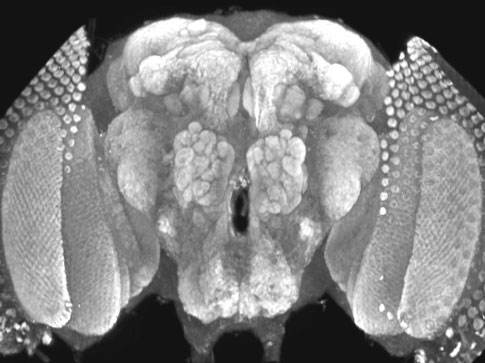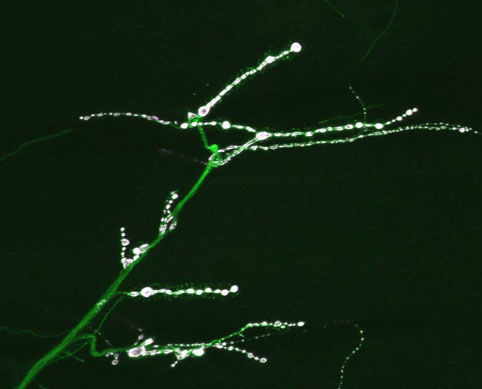|

| |
Epilepsy
 Epilepsy
is a recurrent seizure syndrome caused by pathological synchronized firing of
subpopulations of CNS neurons and is one of the most common neurological
disorders, affecting approximately 3 million people within the US alone. Over
100 known Mendelian diseases include epilepsy as part of the neurological
manifestation. Although epilepsy can be caused by many factors including fever,
ischemic brain insults (stroke), traumatic brain injury or cancer, more than 40%
of patients with epilepsy have been suggested to have a genetic component that
contributes to the etiology. To identify neuronal dysfunctions that cause
epilepsy, we have conducted behavioral screens for temperature-sensitive (TS)
paralytic mutations induced by EMS that result in seizures. To date, 79
seizure-inducing mutations that define 27 complementation groups have been
identified in large-scale screens of homozygous viable lines generated in the
lab. We find that increasing neuronal activity drives
overproliferation of synaptic connections, indicating activity-dependent
rewiring occurs in Drosophila as observed in mammalian epilepsy models.
To analyze transcriptional recoding during altered
neuronal activity, we performed genome-wide DNA microarray analysis following
multiple seizure induction and recovery paradigms in Drosophila
mutants with acute or chronic alterations in neuronal activity.
Approximately 250 genes implicated in cell adhesion, membrane excitability, and
cellular signaling are differentially regulated, identifying a collection
of activity-regulated transcripts that may link
changes in neuronal firing patterns to transcription-dependent modulation of
brain function. RNAi-mediated disruption or overexpression of several of these
transcripts alters synaptic growth, suggesting an important role for
transcriptional regulation in activity-dependent synaptic rewiring. These 250
activity-regulated transcripts represent exciting candidate genes that may
regulate synaptic morphology and synaptic transmission, and will form the basis
for new studies into how the brain responds to enhanced activity that occurs
during plasticity, and in an exaggerated form during epilepsy. Epilepsy
is a recurrent seizure syndrome caused by pathological synchronized firing of
subpopulations of CNS neurons and is one of the most common neurological
disorders, affecting approximately 3 million people within the US alone. Over
100 known Mendelian diseases include epilepsy as part of the neurological
manifestation. Although epilepsy can be caused by many factors including fever,
ischemic brain insults (stroke), traumatic brain injury or cancer, more than 40%
of patients with epilepsy have been suggested to have a genetic component that
contributes to the etiology. To identify neuronal dysfunctions that cause
epilepsy, we have conducted behavioral screens for temperature-sensitive (TS)
paralytic mutations induced by EMS that result in seizures. To date, 79
seizure-inducing mutations that define 27 complementation groups have been
identified in large-scale screens of homozygous viable lines generated in the
lab. We find that increasing neuronal activity drives
overproliferation of synaptic connections, indicating activity-dependent
rewiring occurs in Drosophila as observed in mammalian epilepsy models.
To analyze transcriptional recoding during altered
neuronal activity, we performed genome-wide DNA microarray analysis following
multiple seizure induction and recovery paradigms in Drosophila
mutants with acute or chronic alterations in neuronal activity.
Approximately 250 genes implicated in cell adhesion, membrane excitability, and
cellular signaling are differentially regulated, identifying a collection
of activity-regulated transcripts that may link
changes in neuronal firing patterns to transcription-dependent modulation of
brain function. RNAi-mediated disruption or overexpression of several of these
transcripts alters synaptic growth, suggesting an important role for
transcriptional regulation in activity-dependent synaptic rewiring. These 250
activity-regulated transcripts represent exciting candidate genes that may
regulate synaptic morphology and synaptic transmission, and will form the basis
for new studies into how the brain responds to enhanced activity that occurs
during plasticity, and in an exaggerated form during epilepsy.
|




